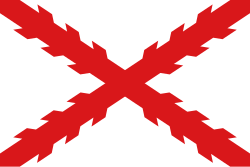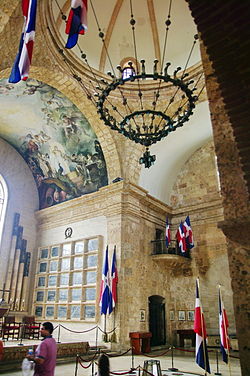Top Qs
Timeline
Chat
Perspective
Flag of the Dominican Republic
From Wikipedia, the free encyclopedia
Remove ads
The national flag of the Dominican Republic is one of the official national symbols of the nation, along with the coat of arms and the national anthem.[1] The blue on the flag stands for liberty, the white for salvation, and the red for the blood of heroes.[2] The civil flag follows the same design, but without the charge in the center, which is the coat of arms of the Dominican Republic.[3][4] The flag was designed by Juan Pablo Duarte.[5]
Remove ads
Description
Summarize
Perspective
As described by Article 21 of the Dominican Constitution, the flag features a centered white Saint George's Cross that extends to the edges and divides the flag into four rectangles; the top ones are blue (hoist side) and red, and the bottom ones are red (hoist side) and blue. The national coat of arms, featuring a shield with the flag, design and supported by a bay laurel branch (left) and a palm frond (right), is at the center of the cross.[2] Above the shield, a blue ribbon displays the national motto Dios, Patria, Libertad (English: God, Homeland, Liberty). Below the shield, the words República Dominicana appear on a red ribbon (this red ribbon is depicted in more recent versions as having its tips pointing upward). In the center of the shield, flanked by three spears (two of them holding Dominican banners) on each side, is a Bible with a small Latin cross above it and said to be opened to the Gospel of John, chapter 8, verse 32, which reads Y la verdad os hará libres (And the truth shall make you free).[2] It is one of 28 national flags to contain overtly Christian symbols.[6]
Remove ads
History
Summarize
Perspective

Spanish colonists had been the first Europeans to claim the island of Hispaniola, but the French had subsequently colonised the western part of it, Saint-Domingue, which later became Haiti, whose flag contained horizontal stripes of red and blue. Haiti subsequently colonised Santo Domingo, the Spanish-speaking part of Hispaniola, and the Haitian colours became the basis of the colours of revolutionary flags in these Hispanophone areas, including the flag of the revolutionary organisation La Trinitaria.
The flag was made to reflect the Christian ideals of Juan Pablo Duarte, the father of the nation, with two white stripes that join together to form a cross, and in the centre a Bible, a cross, and the motto “Dios, patria, libertad” (“God, fatherland, liberty”). The first flags were made by María Trinidad Sánchez, María de Jesús Pina, Isabel Sosa and Concepción Bona. Juan Pablo Duarte designed it and it was first hoisted on February 28, 1844, the day after the beginning of the Dominican Revolution.[7] The ultramarine blue was to represent God's protection over the nation. The vermillion red color represents the blood shed by the patriots in our nation's struggle for freedom. And the white cross in the center symbolizes the peace and unity of the Dominicans.[8]
Remove ads
Use
Summarize
Perspective
The use of the Dominican flag is essentially regulated by Law 210-19, which regulates the use of the national symbols of the Dominican Republic. This law stipulates the following:
- The front side of the flag is the one in which the blue quarter is on the observer's left.
- The flag will never touch the ground.
- The flag will be flown every weekday on all official state buildings and offices, from sunrise to sunset.
- The flag must not be displayed in poor condition (not torn, damaged, or dirty).
- It is the duty of every Dominican to display the flag on national holidays (February 27 or August 16, for example).
- When the flag is flown next to another, it must always be on the right (left of the observer looking at it from the front).
- When the flag is flown vertically, the blue quarter in the upper corner, which is attached to the thick edge of the halyard, should be on the observer's left.
- When the flag is placed horizontally on a wall, the flag shall be hung so that the upper blue quarter, which is attached to the right edge of the halyard, is to the observer's left.
 |
 |
 |
 |
 |
Specific occasions
On days officially declared as national mourning, the flag is first raised to the top of the flagpole and then lowered to half-mast. The coffins of members of the Armed Forces and high-ranking public officials are covered with the National Flag. The celebration of Flag Day was first established in Official Gazette No. 5231 of May 1938, during the rule of Rafael Trujillo. It declared October 24th as Flag Day, Generalissimo Trujillo's birthday. Once the Trujillo Era ended, Law 6085 of October 22, 1962 (Official Gazette 8707 of November 3, 1962) established February 27, the Dominican Independence Day, as the national flag day.
Remove ads
In music and poetry
The poet Gastón Fernando Deligne composed a poem in honor of the Dominican flag called "Arriba el Pabellón" (Up with the Flag). Note that stanzas 7, 8, and 9 discuss the meaning of the flag's colors:
Spanish
El rojo de su gloriosa
decisión dice al oído,
Soy - dice - el laurel teñido
con su sangre generosa.
Es el azul de su anhelo
progresitas clara enseña
color con que el alma sueña
cuando sueña con el cielo.
El blanco póstumo amor
a sus entrañas se aferra
dar por corona a la guerra
el olivo al redentor.
English
The red of his glorious
decision whispers in your ear,
I am, it says, the laurel dyed
with his generous blood.
It is the blue of your longing
progressive, a clear banner of
colour with which the soul dreams
when it dreams of the sky.
The white posthumous love
clings to its depths,
giving as a crown to war
the olive branch to the redeemer.
There is also a national anthem to the flag for schools.
Remove ads
Chronology
Remove ads
Presidential Standard
Other flags
- Flag of Rafael Trujillo
- Naval jack
- Air force ensign
- Police flag
- Flag of Judicial Power and Supreme Court
Historical national flags
- Flag of the Captaincy General of Santo Domingo
- Flag of the Republic of Spanish Haiti
- Flag of the First Dominican Republic
Gallery
- Dominicans in New York Dominican parade holding flags
- Dominican flags at the National Pantheon of the Dominican Republic
- Dominican protesting during the 2020 Dominican Republic protests at the Flag Square of Santo Domingo
- Dominican Army marching on Dominican Independence Day with flags
- Students with the 1844 Dominican Flag
- New York City Police Department holding the Dominican flag at the Dominican Day Parade
- Dominicans with flag in Hermanas Mirabal province
- Dominicans with Dominican Republic flag
See also
References
External links
Wikiwand - on
Seamless Wikipedia browsing. On steroids.
Remove ads






























